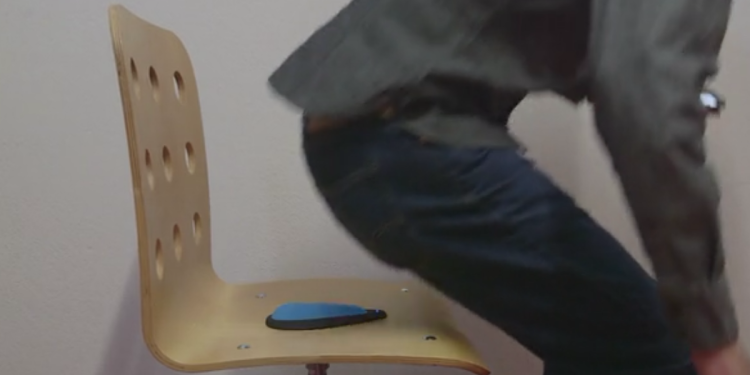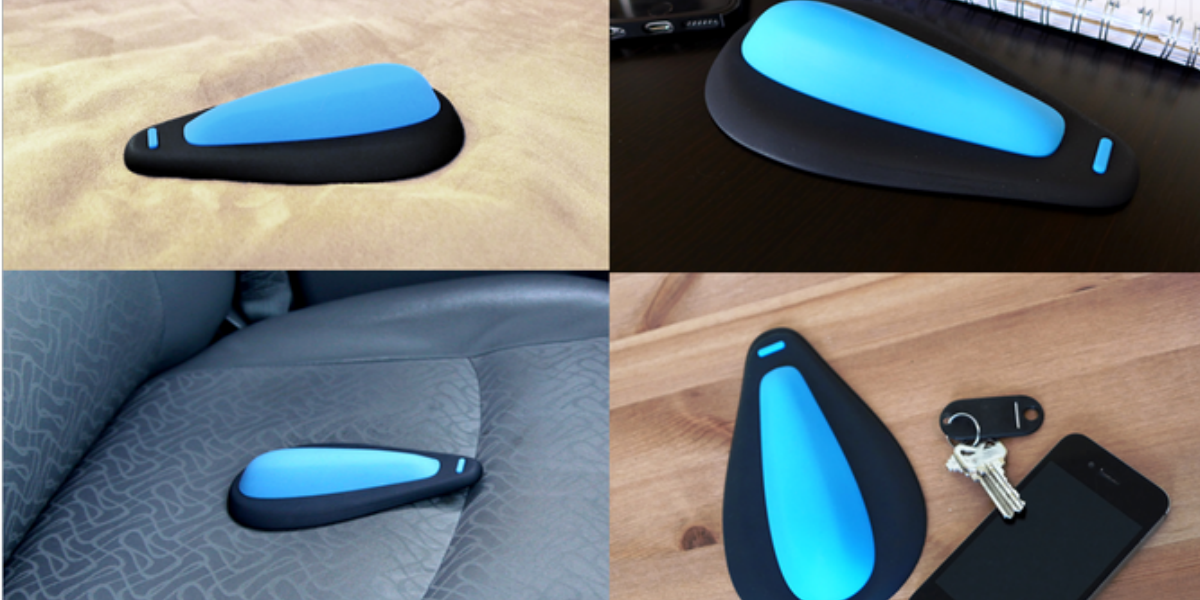I’ve been obsessed with the video game medium for over 30 years now, and I’ve seen mankind’s quest to find new ways of controlling play take some pretty unusual turns.
Yet this is the first time I’ve seen someone suggest I play a game with the flexing power of my nether regions.
Brian Krieger, co-founder and ceo of Minna Life, helped develop the kGoal Boost. This exercise device is shaped like a bicycle seat that the user sits on and connects to a mobile device that tracks the progress of kegel exercises. The company developed a female version of this product last year but has just launched a Kickstarter for the male version.
So what the hell is a kegel? Imagine you’re in the bathroom taking a leak and you decide to control the outward force of your urine stream. Those muscles you feel tensing up down below are your pelvic floor muscles. A kegel rep flexes and releases those muscles.
The exercise supposedly has several health benefits, especially for men looking to improve sexual performance around increasing blood flow and stamina and providing better control over ejaculation.
I had a chance to shoot a couple of questions to Brian Krieger about the kGoal Boost and the challenges of designing a kegel-controlled game.
GamesBeat: So what sparked the idea of kGoal Boost?
Brian Krieger: As a sexual health company, the importance of pelvic floor fitness on many aspects of sexual function has been on our radar for a long time. A combination of two factors makes it a particularly compelling space to explore and really sparked the new product.
First is the magnitude of the potential impact on quality of life. The importance of a healthy sexuality as part of an overall healthy lifestyle is well established, and it’s easy to understand how specific areas where pelvic floor muscles play a large role — like erection performance, stamina and control, or even bladder control — can significantly improve quality of life.
Equally important, though, is the second part of the equation, which is that the level of resources available to improve pelvic floor health — both information and products — is really low.
During our product development user research, we were shocked at the number of men who thought that there was no way to improve various elements of the sexual function or head off future difficulties. That is not the case, and we’re pretty fired up about spreading the word on what can be better and how to make it happen.
GamesBeat: How does the kGoal Boost actually work?
Krieger: The pelvic floor muscles are a network of muscles at the base of the pelvis. Like any other muscle group, they can be exercised by contracting and relaxing them. When you do a pelvic floor muscle, or kegel, your perineum moves.
So, we designed kGoal Boost to measure that. It’s like a miniature bike seat that you sit on, with an inflatable sensor pad under your perineum that detects and tracks kegel reps.
Then, the smart phone app lets you see your exercise history and progress over time. And most importantly, provides guided workouts and games to make the actual process of exercising more fun.
That stems from what was by far the biggest thing we kept hearing during the product development process — doing kegel exercise is really boring.
You can’t see the muscles, they’re inside your abdomen, and you’re just sitting there flexing and releasing. Whether it was from guys who do the exercises or doctors and physical therapists who recommend doing them, everyone kept saying that the biggest problem was just not doing the exercise because it was tedious and boring.
GamesBeat: Is the kGoal Boost only taking one source of input? From what I can tell, it looks like it can only read if I am squeezing or not with my lower pelvic muscles.
Krieger: Yes, it only senses pelvic floor displacement, via changes in air pressure. And it’s important to note that, as with any type of exercise, there is good technique and bad technique.
With kegels, the correct technique is to lift up your pelvic floor muscles, as if you were stopping the flow of urine mid-stream at the same time as you were preventing yourself from passing gas.
Bad technique is bearing down, as if you were trying to poop. kGoal Boost can be a part of helping people practice good technique, but there is definitely an element of user education required beyond just the device itself.
We often compare it to a pedometer or activity tracker. Those products help people be more active — exercise more — by improving their awareness of their activity level and by putting some data around their fitness.
However, they don’t analyze their walking technique or gait. Similarly, kGoal Boost is all about exercise compliance. Although it goes a step beyond pedometers by turning the exercise into a game.
GamesBeat: I’m really interested in the game aspect. How does Brick, the first kegel-based game I’ve ever seen, work with the kGoal Boost?
Krieger: We are still testing different gameplay mechanics, but the underlying concept is that users control the game using their pelvic floor muscles.
In our current prototype, when kGoal Boost senses a pelvic floor muscle contraction, the paddle moves to hit the ball. It’s actually a super fun experience that feels a little like mind control.
Because we can also sense the strength of the muscle contraction, there are a number of proportional control possibilities. For instance, perhaps the harder you squeeze, the faster the paddle will move.
Please also note that the Bricks demo video is of a rough prototype version and not fully representative of what the more polished final product will look and feel like.
GamesBeat: So, how did you approach designing interactivity around squeezing these muscles?
Krieger: Our fundamental design driver is fun. If the game is fun, people will be happy to play it and will be exercising their pelvic floor muscles regularly, which is the whole point.
With that as the north star of the interaction design process, we start by brainstorming different interactions that only require a single analog input. Our entire product development philosophy is extremely iterative, so from there we start prototyping and testing, and usually find that we hone in on something we’re excited about pretty quickly.
GamesBeat: Do you have other games planned?
Krieger: Absolutely, and there are two reasons for that.
First, we know that any game, no matter how fun, can become less interesting over time. So we want to always give users some variety.
However, beyond that, having multiple games enables us to target different elements of muscle performance and functions. Some games may emphasize endurance, where as other will be more focused on motor control, or strength, or fast-twitch response, etc.
GamesBeat: Is there any special software development kit developers will need in order to design apps and games around the kGoal Boost?
Krieger: We are still mapping our strategy and schedule in terms of a potential SDK release.
GamesBeat: You mention the health benefits around doing kegel exercises. Has the kGoal Boost been in use long enough to actually see positive results from users?
Krieger: We have certainly seen improvements in test users, but as a startup, the scale of our user testing is limited. However, the health benefits of pelvic floor exercise in men, as a general topic, has been studied thoroughly, with a number of papers published.
More broadly, kGoal Boost is a fitness aid and not a medical device. As mentioned before, we see it as a tool to promote regular pelvic floor exercise. It is not by itself a treatment or cure for specific medical dysfunction.
To return to a comparison to other exercise tracker devices, wearing a heart rate monitor, for example, may help people exercise more effectively but is not, in and of itself, going to lead to any health benefits.
It’s about exercise and not the device. The device just promotes regular and consistent exercise.
GamesBeat: I read that the kGoal for females reached its Kickstarter sometime last year. Have those products shipped?
Krieger: Yes, last year’s Kickstarter for kGoal, for women, raised $266K against a goal of $90K.
We shipped those products in January and February of this year and have been very pleased with the response from users. In fact, hearing from so many men asking if they could use something like kGoal, or if we had a product to help them improve their pelvis floor fitness, was a big part of driving us to develop kGoal Boost.
GamesBeat: Is the male version still in Kickstarter? When can we expect those units to ship?
Krieger: Yes, the Kickstarter campaign will run until January 3, 2016. And we are planning to ship the products in July 2016. Backing the campaign is a great way to get one of the first-ever devices and at a nice discount from the normal price.
VentureBeat's mission is to be a digital town square for technical decision-makers to gain knowledge about transformative enterprise technology and transact. Learn More



